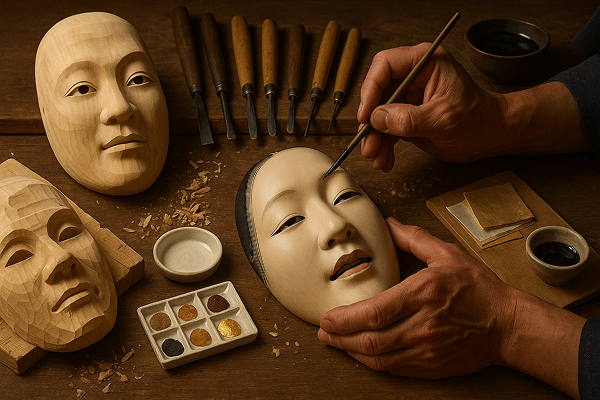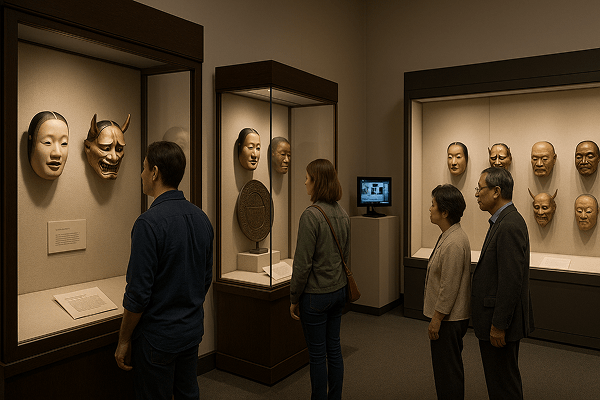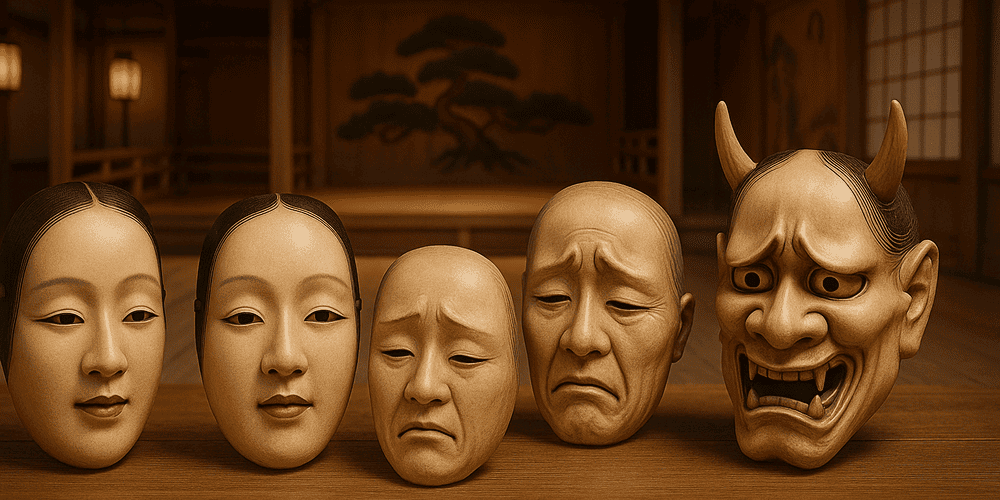Noh Theatre Masks are among the most celebrated and enigmatic artifacts of Japanese culture, renowned for their subtle beauty and profound impact on the world of performance art. Used in the highly stylized classical Japanese theatre form known as Noh, these masks are instantly recognizable by their serene, often ambiguous expressions and delicate craftsmanship. Typically carved from lightweight wood and finished with natural pigments, gold leaf, and lacquer, Noh Masks are designed to convey a wide range of emotions depending on lighting, angle, and the movements of the performer. Originating in medieval Japan, particularly during the Muromachi period (14th–16th centuries), Noh Theatre Masks remain a central element of Japan’s artistic and spiritual heritage.
Historical Origins
The history of Noh Theatre Masks is deeply intertwined with the evolution of Japanese performing arts. The term “Noh” (能) means “skill” or “talent,” reflecting the refined artistry required in this ancient dramatic tradition. The earliest forms of masked performance in Japan can be traced to religious rituals and court entertainments of the Nara (710–794) and Heian (794–1185) periods, where masks were used in bugaku (court dance) and gigaku (masked drama).
Noh theatre as it is known today was codified during the Muromachi period by playwrights and performers such as Kan’ami and his son Zeami. The use of masks became central, allowing a small cast to portray a vast array of supernatural beings, spirits, women, and aged characters. The design of Noh Masks gradually evolved from simple, exaggerated forms to highly sophisticated carvings capable of expressing subtle shifts in mood and personality. Historic masks from the Muromachi and Edo periods are treasured as national cultural properties, with many preserved in temples, shrines, and museum collections.
Cultural Significance and Symbolism
Noh Theatre Masks hold deep symbolic meaning in Japanese culture, serving as conduits between the human and spiritual realms. Each mask is imbued with its own character and backstory, representing gods, demons, ghosts, women, warriors, or old men. The act of donning a Noh Mask is considered a spiritual transformation, allowing the performer to transcend individuality and embody the essence of the role.
Noh Masks are linked to Shinto and Buddhist traditions, where masks were used in rituals to appease spirits, invite divine favor, and ward off evil. Legends and folktales, such as those surrounding the hannya – female demon – mask, highlight the emotional and supernatural power attributed to these objects. Socially, Noh Masks have long been associated with the elite samurai class and religious institutions, reinforcing their status as symbols of high culture and spiritual depth.
In the broader context of Japanese mask traditions, Noh Theatre Masks stand alongside other iconic forms such as Kitsune Masks, which represent the mystical fox spirit in folklore and festival performance.
Materials and Craftsmanship
The creation of a Noh Theatre Mask is a meticulous and revered art, often passed down through generations of master carvers. Traditional masks are crafted from lightweight Japanese cypress (hinoki), chosen for its fine grain and durability. The process involves several intricate steps:
- Rough carving the basic shape using chisels and knives.
- Refining facial features to achieve the mask’s characteristic ambiguity and subtlety.
- Smoothing and hollowing the interior to ensure comfort and proper resonance for the performer’s voice.
- Applying layers of gofun – a white pigment made from oyster shell – natural pigments, gold or silver leaf, and lacquer for color, texture, and preservation.
- Painting delicate details such as eyebrows, lips, and lines to enhance expression.

Some masks are adorned with real hair, metal inlays, or other embellishments. Regional schools and master craftsmen, such as those in Kyoto and Tokyo, have developed distinct carving styles and finishing techniques. Color symbolism is essential: white often signifies purity or the supernatural, red can represent anger or passion, and gold may denote divinity or nobility.
Functions and Usage
Noh Theatre Masks serve multiple roles in Japanese culture:
- Ritual and Ceremonial Use: Historically, masks were used in religious festivals and temple ceremonies to invoke deities and spirits.
- Theatrical Application: In Noh theatre, masks are worn by main characters to portray supernatural beings, women, elders, and other archetypes. The mask allows the actor to transcend individual identity and fully inhabit their role.
- Festivals and Celebrations: While Noh Masks are primarily associated with formal stage, they occasionally appear in traditional processions and local festivals.
- Evolution Over Time: The use of masks has remained largely unchanged in Noh, preserving centuries-old performance conventions. However, contemporary artists and performers sometimes adapt Noh Masks for experimental theatre, visual art, and cultural exhibitions.
Regional Variations
Although the core tradition of Noh Masks is consistent across Japan, regional schools and individual carvers have developed unique features. For example, Kyoto-based mask makers may favor more refined, delicate expressions, while Edo (Tokyo) craftsmen might emphasize bolder lines or dramatic features. Some local festivals outside the Noh tradition have adopted Noh-style masks for their own ritual performances, blending regional folklore with classical aesthetics.
Comparisons with other mask traditions, such as Korean Tal Masks, Chinese Nuo Masks, or Japanese Kitsune Masks, reveal both shared and unique approaches to symbolism, design, and performance.
Notable Examples and Collections
Some of the finest and most significant Noh Theatre Masks are preserved in prominent museums and collections:
- Tokyo National Museum: Houses historic masks from the Muromachi and Edo periods, some designated as Important Cultural Properties.
- Kyoto National Museum: Showcases classical masks and related artifacts.
- Nara National Museum: Features masks with religious and ritual significance.
- Private Collections: Some of Japan’s oldest temple and shrine treasuries contain masks with centuries-old provenance.
- Online Galleries and Resources: Platforms like toddmasks.com provide access to both antique and contemporary Noh Masks, offering educational insight and opportunities for collectors.

Archaeological finds, literary references, and preserved stage paraphernalia further document the evolution of Noh Masks.
Influence on Art and Culture
The influence of Noh Theatre Masks extends far beyond the stage. Their minimalist aesthetic and emotional ambiguity have inspired generations of Japanese artists, poets, and filmmakers. Noh Masks appear in literature, such as Yukio Mishima’s “The Mask”, and feature prominently in visual arts, contemporary sculpture, and even fashion design. Their presence in film, animation, and global theatre reflects the universal appeal of their mysterious beauty.
Noh Masks also play a vital role in preserving traditional Japanese aesthetics and values, serving as emblems of cultural resilience and artistic discipline. Their expressive forms have influenced modern mask-making and performance art worldwide, and they are regularly featured in international exhibitions and collaborations.
Contemporary Status and Tradition Preservation
Today, the tradition of Noh Mask carving and performance is actively preserved by master artisans, theatre troupes, and cultural organizations throughout Japan. Apprenticeship systems, formal schools, and government recognition (such as designation as Important Intangible Cultural Property) ensure the transmission of skills and knowledge.
Contemporary artists experiment with new materials, digital techniques, and cross-cultural collaborations, bringing fresh perspectives to the ancient art. Educational programs, workshops, and master classes introduce the next generation to the craft, while museums and online platforms like toddmasks.com promote global awareness and appreciation.
Collecting and Acquisition
The market for Noh Theatre Masks ranges from affordable modern replicas to priceless antiques. Authentic masks can be found at reputable galleries, museum shops, and through direct commission with master carvers. Factors influencing value include age, provenance, craftsmanship, condition, and artistic lineage.
Collectors should seek provenance, expert evaluation, and ethical sourcing – ensuring that cultural property laws are respected and that living traditions are supported. Buying from recognized artists and platforms like toddmasks.com helps sustain the craft and connects collectors with the living heritage of Japanese Noh.
